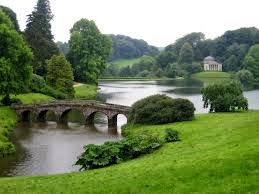Before this class, I never really put much thought into what
goes into gardens and the significance they have had throughout history,
especially in Europe. As we learned about each type, I always found a feature I
enjoyed in each one. Each type of garden was unique and had a different
character and feel to it. Even though I liked all the gardens we studied, it
was when we came upon the English landscape garden that I found my favorite.
Most of the other gardens were very beautiful and intricate
but the English landscape garden took a much different approach. Contrary to
the styles that came before it, it was made to look as though man did not play
a role in the creation of it. The focus was on the “natural” beauty that could “only
come from nature itself”. I really enjoy places that have a view and I thought
that it was interesting and beautiful that the landscape designers used the
borrowed views to extend the garden far beyond the actual bounds. When I think
about what a garden should be and what I enjoy about being in a garden is that
you are able to escape into nature. The English landscape garden was the one
that I thought was able to communicate that.
I found it so interesting to be able to study all the
different types of gardens that Europe has to offer. Each and every one was
beautiful and unique. Although I enjoyed all of them, I felt that the English
landscape garden really represented what I thought a garden should be about. It
was a place to go and enjoy what nature looked like and even though it was
still man made, I felt that it accomplished that.
For more information on the English Landscape Garden, check out this link:
http://www.gardenvisit.com/history_theory/library_online_ebooks/ml_gothein_history_garden_art_design/english_landscape_garden_designers
Photo Links:
http://en.wikipedia.org/wiki/English_landscape_garden
http://traveltrales.wordpress.com/category/natural-britain/
http://www.historyextra.com/feature/english-landscape-garden
















